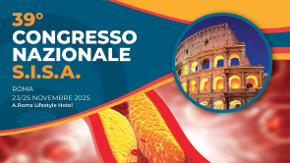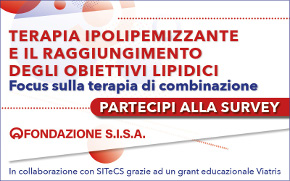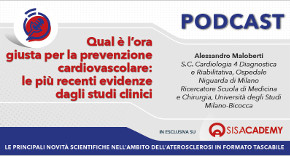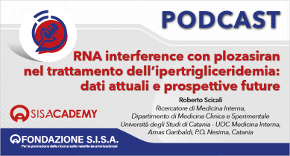 Rivista in lingua italiana
Rivista in lingua italiana
riservata ai Soci SISA
Ultimo numero:
Anno 16 • N.1/2025
SISANews
Efficacia di Evolocumab nei pazienti con malattia arteriosa periferica degli arti inferiori
In questa sottoanalisi del trial FOURIER su pazienti con arteriopatia periferica (PAD), evolocumab ha portato a una riduzione significativa dell'end point primario (composito di morte cardiovascolare, infarto miocardico, ictus, ricovero ospedaliero per angina instabile o rivascolarizzazione coronarica), più consistente di quanto osservato nel pazienti senza PAD (hazard ratio 0,79 vs 0,86). I pazienti con PAD sono ad alto rischio di eventi cardiovascolari e l'inibizione di PCSK9 con evolocumab ha ridotto significativamente tale rischio. Inoltre, l'abbassamento del colesterolo LDL con evolocumab ha portato a una riduzione del rischio di eventi avversi maggiori agli arti.
![]()
Low-Density Lipoprotein Cholesterol Lowering With Evolocumab and Outcomes in Patients With Peripheral Artery Disease: Insights From the FOURIER Trial (Further Cardiovascular Outcomes Research With PCSK9 Inhibition in Subjects With Elevated Risk)
Bonaca MP, Nault P, Giugliano RP, Keech AC, Pineda AL, Kanevsky E, Kuder J, Murphy SA, Jukema JW, Lewis BS, Tokgozoglu L, Somaratne R, Sever PS, Pedersen TR, Sabatine MS.
Circulation 2018;137:338-350
BACKGROUND: The PCSK9 (proprotein convertase subtilisin/kexin type 9) inhibitor evolocumab reduced low-density lipoprotein cholesterol and cardiovascular events in the FOURIER trial (Further Cardiovascular Outcomes Research With PCSK9 Inhibition in Subjects With Elevated Risk). We investigated the efficacy and safety of evolocumab in patients with peripheral artery disease (PAD) as well as the effect on major adverse limb events.
METHODS: FOURIER was a randomized trial of evolocumab versus placebo in 27 564 patients with atherosclerotic disease on statin therapy followed for a median of 2.2 years. Patients were identified as having PAD at baseline if they had intermittent claudication and an ankle brachial index of <0.85, or if they had a prior peripheral vascular procedure. The primary end point was a composite of cardiovascular death, myocardial infarction, stroke, hospital admission for unstable angina, or coronary revascularization. The key secondary end point was a composite of cardiovascular death, myocardial infarction, or stroke. An additional outcome of interest was major adverse limb events defined as acute limb ischemia, major amputation, or urgent peripheral revascularization for ischemia.
RESULTS: Three thousand six hundred forty-two patients (13.2%) had PAD (1505 with no prior myocardial infarction or stroke). Evolocumab significantly reduced the primary end point consistently in patients with PAD (hazard ratio [HR] 0.79; 95% confidence interval [CI], 0.66-0.94; P=0.0098) and without PAD (HR 0.86; 95% CI, 0.80-0.93; P=0.0003; Pinteraction=0.40). For the key secondary end point, the HRs were 0.73 (0.59-0.91; P=0.0040) for those with PAD and 0.81 (0.73-0.90; P<0.0001) for those without PAD (Pinteraction=0.41). Because of their higher risk, patients with PAD had larger absolute risk reductions for the primary end point (3.5% with PAD, 1.6% without PAD) and the key secondary end point (3.5% with PAD, 1.4% without PAD). Evolocumab reduced the risk of major adverse limb events in all patients (HR, 0.58; 95% CI, 0.38-0.88; P=0.0093) with consistent effects in those with and without known PAD. There was a consistent relationship between lower achieved low-density lipoprotein cholesterol and lower risk of limb events (P=0.026 for the beta coefficient) that extended down to <10 mg/dL.
CONCLUSIONS: Patients with PAD are at high risk of cardiovascular events, and PCSK9 inhibition with evolocumab significantly reduced that risk with large absolute risk reductions. Moreover, lowering of low-density lipoprotein cholesterol with evolocumab reduced the risk of major adverse limb events.
CLINICAL TRIAL REGISTRATION: URL: https://www.clinicaltrials.gov. Unique identifier: NCT01764633.

Area Soci
Eventi
39° Congresso Nazionale
 39° Congresso Nazionale
39° Congresso NazionaleRoma, 23-25 novembre 2025
Save the date




 Spring Meeting Gruppi Giovani SID, SIGG, SIIA, SIMI, SIPREC, SISA
Spring Meeting Gruppi Giovani SID, SIGG, SIIA, SIMI, SIPREC, SISARimini, 6-8 aprile 2025
[continua a leggere]
 SISA LIPID ACADEMY - Corso avanzato di lipidologia clinica
SISA LIPID ACADEMY - Corso avanzato di lipidologia clinicaModena, 4-5 Luglio 2024
[continua a leggere]Giornale Italiano Arteriosclerosi
HoFH today
 Rivista Italiana della
Rivista Italiana della
Ipercolesterolemia
Familiare Omozigote
Anno 6 • N.1/2024
Rivista NMCD
Diateca
[continua a leggere]
[continua a leggere]
Newsletter
il vostro indirizzo di posta elettronica
Progetto LIPIGEN

Nuovo sito dedicato al Progetto LIPIGEN
Progetto LIPIGEN - Vecchio portale
E' necessario essere loggati come utente
Lipigen per poter accedere alla pagina
PROject Statin Intolerance SISA
PROSISA – PROject Statin Intolerance SISA
E' necessario essere loggati come utente
PROSISA per poter accedere alla pagina
GILA - Lipoprotein Aferesi
Gruppo Interdisciplinare Lipoprotein Aferesi
(Accesso Gruppo GILA-Lipoprotein Aferesi)
E' necessario essere loggati come utente del Gruppo GILA per poter accedere
Gruppo Interdisciplinare Lipoprotein Aferesi
(Documentazione ad accesso libero)
Pagina informativa per medici e pazienti










